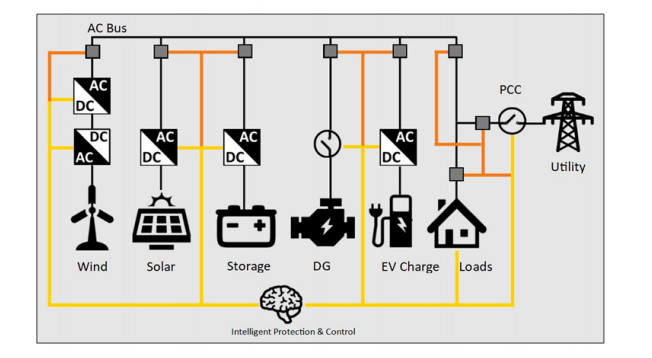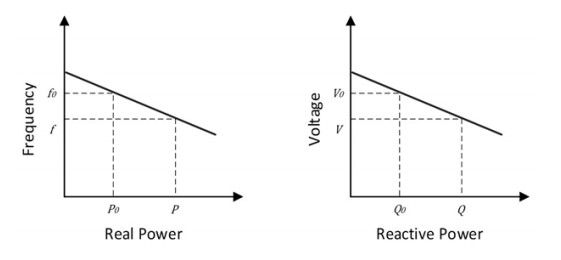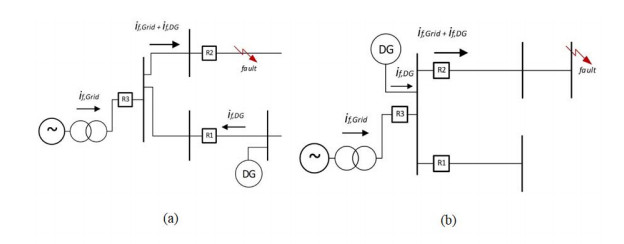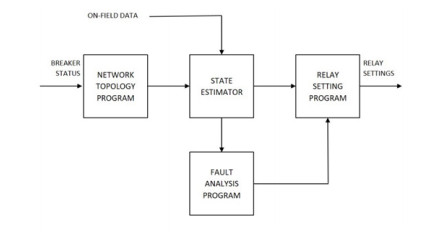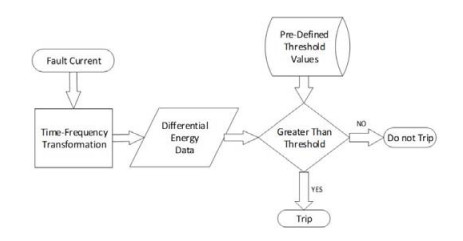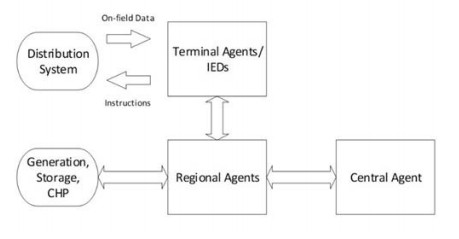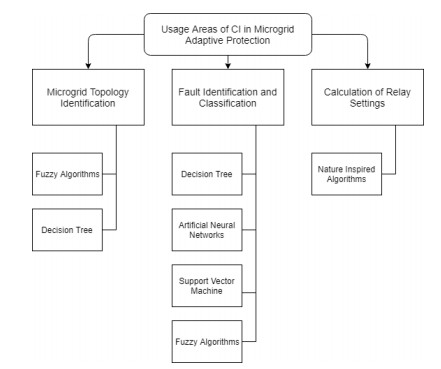Microgrids have gathered a significant amount of attention within the past decade and becoming an essential asset in the energy industry. The ability to integrate sustainable energy generation methods into the distribution network is one of the main reasons for microgrids popularity. A wide variety of Distributed Generation (DG) including wind and other micro-turbine generation, photovoltaic generation along with energy storage, makes the microgrid viable in both grid-connected and islanded modes while reducing the power losses. There are various technical challenges to be tackled in order to harvest the full potential of microgrids, and protection is one of them. Various solutions were introduced, driven by the development of protection techniques. One of the most promising approaches for microgrid protection is adaptive protection. This paper contains a systematic review on adaptive protection of microgrids, including a wide range of applicability variants, their strengths, and drawbacks. It also explores the state-of-the-art researches that utilize computational intelligence to achieve adaptive protection. These solutions are currently at the verge of totally redefining protection solutions with a more flexible and reliable system that will be applied globally.
1.
Introduction
When searching the literature, we noticed that several propositions have been made by several researchers to find kernels that can be used to obtain fractional differential operators. The main reason for this is that, real world problems show signs of processes resembling behaviors of some mathematical functions. Riemann, Liouville, Cauchy and Abel works have led to a fractional calculus with a power law kernel. Their work was later modified by Caputo; this version has been used in many fields of science because of its ability to allow classical initial conditions [1]. Prabhakar suggested a different kernel as a product of power-law and the generalized Mittag-Leffler function with three parameters. This version has also attracted the attention of many researchers, studies have been done on theory as well as on applications. Indeed, the two kernels have their specific values, for example, power-law helps only to replicate processes exhibiting power-law behavior, while the product of the power-law and the generalized three-parameters Mittag-Leffler has also its field of application [2]. As nature is complex, a new kernel was suggested by Caputo and Fabrizio, a special exponential kernel with Delta Dirac properties. A differential operator that is in fashion nowadays due to its ability to replicate processes following fading memory. Indeed, this kernel brought a new shift into fractional calculus, as the concept of the fractional derivative with a non-singular kernel was introduced [3]. A point made by some researcher about the non-fractionality of the kernel led to a new kernel, the generalized Mittag-Leffler function with one parameter. This version was suggested by Atangana and Baleanu, constituting another new step forward in the field of fractional calculus. The operators have been used in several fields of studies with great success [4]. In [5], the basic theory of fractional differentiation, existence-uniqueness theorems and analytical numerical methods of solution of fractional differential equations are presented. In [6], the authors examined Noether's theorems of fractional generalized Birkhoffian systems in terms of classical and combined Caputo derivatives. The development of the time-fractional damage model for hyperelastic body is considered in [7]. While looking at nature and its complexities, one can with no doubt conclude that these suggested kernels are not enough to predict all complex behaviors of our universe. On this note, one will proceed to search for a different kernel or modified kernel, or a class of functions that will be used to introduce new differential operators. Sabatier recently presented some variants of kernels that will also open new doors for investigation [8]. In addition to these outstanding contributions, several other ideas have been suggested, for example the concept of short memory was suggested and a fractional derivative in the Caputo sense has been defined for different values of fractional orders. The idea is to have a different type of variable-order derivative unlike the well-known version that considers a fractional orders. The idea is initiated to have a different type of variable order derivative unlike the well-known version that considers a fractional-order to be a function of time. This case was suggested by Wu et al. [9] and applied in chaos. On the other hand, researchers have noticed that several real-world problems exhibit processes with different behaviors as a function of time and space. A particular case is a passage from deterministic to stochastic, or from power law to exponential decay. It was noted that existing differential operators may not be able to account for these behaviors, thus piecewise differential and integral operators were introduced to deal with problems exhibiting crossover behaviors [10]. The main aim of this note is to provide a critical analysis of the possible applications, advantages, and disadvantages of these two concepts.
2.
Motivation for piecewise derivatives
We will illustrate the motivation with some examples.
Death body decay in different temperatures. Consider a corpse found in a snowy place, and assume that such body has been found after 20 days. The corpse is taken and brought to the house and kept in a normal temperature for a few days and later put in a mortuary and buried. The main aim here is to replicate the process of decay. The first part will provide a very low decay. The second part will provide a fast decay, the third part will again be a fast process and finally, a slow process. Indeed, slow and fast processes can be characterized by some mathematical functions. The power-law function is
The exponential decay function with a Dirac delta property is
However, a crossover from fast to slow decay processes can be modeled using the following Mittag-Leffler function with Delta-Dirac property
The process can be divided into several intervals to capture each behavior. In the first part, one can have
The second processes can be
The two last parts will be characterized by
Thus the whole process will be a system with the following crossover behaviors
Therefore in general the concept of piecewise derivative has been introduced.
3.
Short memory concept
In this section, we present the definitions of both short memory and piecewise differentiation. For the short memory case, the idea has already been discussed; for example a paper published by Deng in 2007 has already discussed the short memory principle [11], which has also been called the fixed memory principle and logarithmic memory principle. Wu et al. [9] presented the concept of a fractional variable-order derivative where the fractional order changes within an interval. The suggested definition is given below as:
Here Caputo power law derivative is used, which is known to have a singularity at the origin for a class of functions. The author did not give explicitly space of the functions as the derivative was defined in general, therefore, if we assume a class of the functions for which dydt is continuous then at each t=ti, f(y,t) should be zero.
On the other hand, the piecewise concept is defined as follows.
1) A piecewise derivative of f with classical, power-law and stochastic processes is given by
2) A piecewise derivative of f with power, exponential and Mittag-Leffler laws is given as
Several definitions can be found in [10].
In the next section, we will provide a deep analysis of these concepts.The aim of the section is to present advantages and disadvantages of these two independent concepts. We note that
4.
Analysis and difference
Here, we present a deep analysis that will help the readers to see the difference between the two concepts. Let us start with short memory. A deep look inside the short memory concept defined by gives the following:
1) The short memory principle considers a change in constant variable order; however, it uses a single kernel. Indeed, this can be viewed as variable order where the order is changed within shorter intervals. Nonetheless, it describes some process and in the case of Caputo derivation, this process will only describe a power-law process that is, this process will not have crossover behavior.
2) The concept is unable to capture classical processes because the fractional order should change in each interval.
On a serious note, however, if we have f(t,y(t))≠0,∀t∈[0,T]. So at each tj
Sincedydt is continuous,
However the right hand side produces f(t,y(t))≠0, which is a contradiction. It infers that f(tj,y(tj))=0. This may be used to explain the process with a renewal force that follows the power-law process. For example, the trajectory of a flea with a constant jump. There are fewest real world problems that present these behaviors. However, due to the power-law singularity the definition suggested by Wu may have some problems at the boundaries. Nonetheless, as a result of using non-singular kernels, the concept of short memory will be well-posed since the conditions at the boundaries will be well controlled and the renewal processes would be well-posed
On the other hand, however, the concept of piecewise was introduced for different purposes. The following example will give light to the situation. We consider evaluating the velocity of water within a geological formation with fractures. We record the velocity as a function of time. The velocity will obviously be low in the rock's matrix; however as the water reaches the fracture, there will be a crossover behavior because the velocity will suddenly increase. The first part of this process follows behaviors resembling a declining process and, later, an almost constant high velocity. Now if one was to withdraw water from such a geological formation and record the water level, one will observe a fading groundwater level in earlier times; then when water is being taken from the fracture, we observe a steady groundwater level. Thus, there is a crossover behavior from the fading process to long range, which can be captured using an exponential function, then the power law. Therefore, the differential operator able to replicate this process is
Therefore, one can see a clear difference and objectives of both concepts. Piecewise differential operators are thus conceived to capture processes exhibiting different patterns, or crossover behaviors. Here the order does not change within an interval as changing order does not change the process but only the memory with the same pattern, rather, the kernels change to bring into the mathematical formulation the crossover behaviors by each kernel.
For example, using the piecewise derivative the decay equation
which will lead to decay with crossover behaviors. From 0<t<T1, we shall observe a normal decay process. From T1<t<T2, we shall observe power-law decay or the Mittag-Leffler decay. From T2<t<T, we shall observe decay with randomness. On the other hand, with the short memory
which leads only to a power-law process or the Mittag-Leffler process.
5.
Application to real world problems
In this section, we shall present clearly the difference between the two concepts by applying them to some problems. We shall start with a simple problem about the decay problem with two intervals.
Example 1. We consider a simple decay model within [0,T1] and [T1,T2]. In the case of short memory, we have
In the case of piecewise, we can consider the following
or
or
Using the Laplace transform on the above system yields in the case of short memory
In the case of piecewise, we have the following solution
or
or
T1=1 where the crossover occurs and T2=2.4 is the final time. The numerical simulations are presented in Figures 1–4 below.
Example 2. We consider the spread of an infectious disease. We consider a Susceptible, Exposed, Infected and Recovered (SEIR) model. It was proven by Atangana and Seda that such a model may not be able to predict waves [12]. Thus to introduce waves, in particular two waves, we consider the spread to be in the periods [0,T1] and [T1,T2]. In the case of short memory, we have
In the case of piecewise several scenarios can be obtained. So we can have
or
Noting that several more scenarios can be considered, however, we will only consider these two in the case of piecewise. Before proceeding with the analysis of these models, we shall first provide an interpolation of each case in terms of wave behaviors. In the case of short memory, the first and second waves show the non-Gaussian distribution associated to the power-law variables t−α1 and t−α2. Therefore, one will observe different long tails for t−α1 and t−α2. On the other hand, however, the first considered model shows that the first wave has a normal distribution, while the second wave has random behavior. The second model shows that the first wave has a long tail spread while the second has random behavior.
We now present the numerical solutions of the considered models. We shall consider the numerical scheme suggested by Ghanbari et al. [13] for fractional cases. The short memory case can be simplified to
Applying the Ghanbari method yields
where
and
In the case of the piecewise first model, we have
For Case 2, we obtain
The numerical solutions for short memory are depicted in Figure 5 with the following parameters
and the following initial conditions
The numerical solutions for Cases 1 and 2 are respectively depicted in Figures 6 and 7 with the following parameters
and the following initial conditions
Figure 5 demonstrates the short memory effect, where the first and second parts present different long tails behaviors characterized by α1 and α2; however, both clearly depict the same process which is the power law process. On the other hand, Figures 6 and 7 show the clear effects of the piecewise differential operators; the first part in Figure 6 shows normal distribution, which is characteristic of the classical differential operator, while the second part clearly shows the effect of randomness. The complete model therefore shows crossover behavior from deterministic to stochastic with no steady state. In Figure 6, the process is different. We start with randomness then end up with long tail behaviors as a result of the power law kernel.
Example 3. We now consider a chaotic problem in particular the 8-wing attractor [14]. This model has been studied by several researchers [15], the model is given as
where the function f(t)=M sgn(sin(wt))+K. The constant w is known to be a switch frequency and M and K are constant parameters.
In the case of short memory, we have
In the case of piecewise, we can consider three cases. For Case 1, we can write
For Case 2, we have
For Case 3, we can get
We shall now present the numerical solution of each case. In the case of short memory, one can use the numerical method based on Lagrange interpolation [16]. We can first simplify the model as follows.
Thus, applying such method to the above system yields
With the piecewise case, we obtain the following numerical solution by using a scheme based on Newton polynomial interpolation [17]. Also, we simplify the model as follows.
Then applying this method yields
For Case 2, we again apply the scheme with the Newton polynomial to obtain
where Cn2∈[tn2+4,tn2+3]. For Case 3, we use the simple Adams-Bashforth methods as follows
where Cn2∈[tn2+4,tn2+3].
Numerical solutions are obtained for the following parameters
The numerical solutions for short memory are depicted in Figure 8 for the initial data x(0)=22.3,y(0)=4.9 and z(0)=2.6.
For piecewise, we consider the following stochastic-deterministic problem with power-law and Mittag-Leffler kernels:
with the stochastic constants
The numerical simulation for such a problem can be performed as illustrated in Figure 9 by using the same initial data and parameters.
For piecewise, we consider the following stochastic-deterministic problem with power-law and Mittag-Leffler kernels:
with the following stochastic constants
The numerical simulation for such a problem can be performed as shown in Figure 10 by using the same initial data and parameters.
Also, we consider the following deterministic-stochastic problem with power-law and Mittag-Leffler kernels:
with the following stochastic constants:
The numerical solutions for the above problem can be depicted as shown in Figure 11 using same initial data and parameters.
Figure 7 shows the results obtained by applying the power-law short memory concept. To show the difference within the interval, we have opted to consider the first part of the interval to be in blue and the second to be in red. However, a quick look at the results shows clearly the effect of a power law, no great change from one interval to another is observed since both depict long-tail behaviors as results of the power-law kernel. In this case, there is no crossover behavior, just a repetition of different long tail behaviors. On the other hand, in Figures 8 and 9, there is a clear change in patterns where the first patterns show deterministic behaviors in particular, long-tails due to power law in Figure 8, and the second part shows randomness, there is, therefore, a clear crossover from power law to randomness. While, in Figure 9, we have two crossovers, the first is due to the Mittag-Leffler kernel that shows a change from stretched exponential to power law and the second is stochastic.
Also, we consider deterministic-stochastic problem with power-law and Mittag-Leffler kernel
with the following stochastic constants:
The numerical solutions for the above problem can be depicted as shown in Figure 12 by using the same initial data and parameters.
6.
Conclusions
In the last decades, researchers have devoted their attention to better understanding complex realworld problems even on a small scale. They have therefore developed several methods, different differential, and integral operators. To understand the process by which different long tails occur in different intervals, the concept of short memory was introduced. This concept defines power-law derivatives in different intervals and each interval has its own order. This order accounts for the long tail associated with that interval. However, the process is scale-invariant in terms of patterns. On the other hand, because there are many real-world problems that exhibit passages from one process to another, for example, a passage from power law to randomness, the concept of piecewise was introduced. In this work, a detailed analysis was given to show their different fields of applications and show also, when short memory and piecewise concepts can be applied. This paper thus helps researchers to identify what problem is suitable for short memory and piecewise.
Conflict of interest
The authors declare there is no conflict of interest.
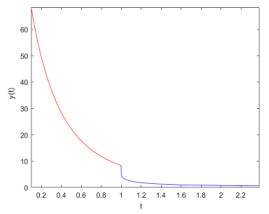









 DownLoad:
DownLoad:













